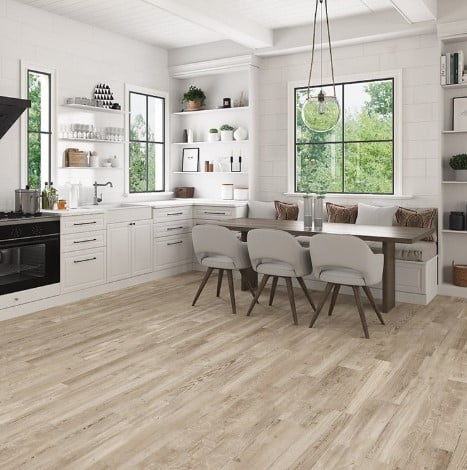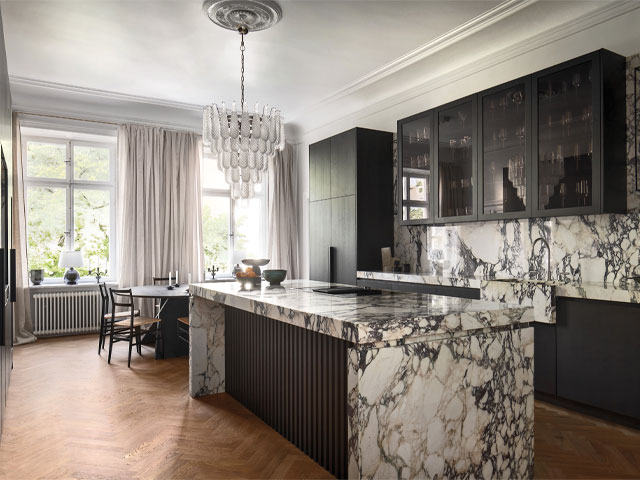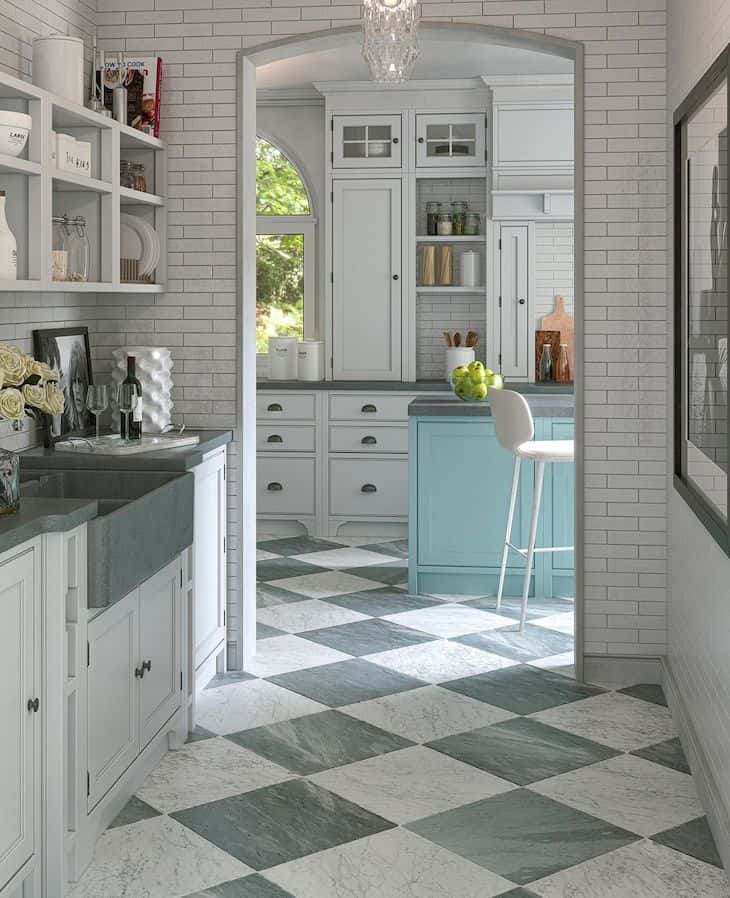
Top Factors to Consider Before Choosing Kitchen Flooring
Water Resistance and Spills
Kitchens get wet often with splashes and spills. Pick flooring that handles water well without damage. Good choices include luxury vinyl, tile, and some engineered hardwood types.
Durability for Heavy Foot Traffic
Kitchens are busy with lots of walking. Floors should be strong against movement, dropped items, and shoe wear. Choose materials that don’t dent or scratch easily.
Comfort Underfoot
If you stand a lot while cooking, comfy floors help. Materials like cork or vinyl provide more cushion than hard ones like tile. Consider using mats for extra softness.
Ease of Cleaning and Maintenance
Kitchens are messy places. Choose floors that are easy to clean, like tile, sealed hardwood, or vinyl, which resist stains and are simple to maintain.
Visual Style and Design Cohesion
Your kitchen floor affects the room’s look. Match floor color and texture with cabinets and countertops. Whether you like wood tones or sleek tiles, ensure your floor fits the design.
Kitchen Flooring Factors Comparison Chart
| Material | Water Resistance | Durability | Comfort | Maintenance | Style Compatibility |
|---|---|---|---|---|---|
| Luxury Vinyl Plank (LVP) | ✅ Waterproof | ✅ High | ✅ Soft | ✅ Easy | ✅ Versatile |
| Porcelain Tile | ✅ Waterproof | ✅ High | ❌ Hard | ✅ Easy | ✅ Modern/Classic |
| Ceramic Tile | ✅ Water-Resistant | ✅ High | ❌ Hard | ✅ Easy | ✅ Traditional |
| Hardwood | ❌ Not Ideal | ✅ High | ✅ Warm | ❌ Moderate | ✅ Timeless |
| Engineered Wood | ⚠️ Water-Resistant | ✅ Moderate | ✅ Warm | ⚠️ Moderate | ✅ Contemporary |
| Laminate | ⚠️ Water-Resistant | ✅ Moderate | ⚠️ Moderate | ✅ Easy | ✅ Modern |
| Sheet Vinyl | ✅ Waterproof | ✅ Moderate | ✅ Soft | ✅ Easy | ✅ Varied |
| Cork | ⚠️ Water-Resistant | ⚠️ Moderate | ✅ Cushioned | ⚠️ Moderate | ✅ Eco-Friendly |
| Concrete | ✅ Waterproof | ✅ High | ❌ Hard | ✅ Easy | ✅ Industrial |
| Natural Stone | ⚠️ Water-Resistant | ✅ High | ❌ Hard | ❌ High | ✅ Luxurious |

Best Kitchen Flooring Materials (Pros & Cons)
Choosing the right kitchen flooring involves finding a balance between style, performance, and practicality. Here are the top kitchen flooring options for 2025, along with their benefits and drawbacks:
Hardwood Flooring in the Kitchen
Pros: Gives a warm, classic look and boosts home value.
Cons: Can get damaged by water and may warp if not sealed.
Luxury Vinyl Plank (LVP) in the Kitchen
Pros: Popular choice for kitchens, LVP is waterproof, budget-friendly, and looks like wood or stone with soft feel.
Cons: Cheaper LVP might dent or fade with heavy use or sunlight.
Tile Flooring in the Kitchen (Ceramic & Porcelain)
Pros: Tile is durable, water-resistant, and comes in many colors and finishes.
Cons: Feels cold and hard, may need rugs or heating for comfort.
Laminate Flooring in the Kitchen
Pros: Cost-effective option with modern looks and easy-to-clean, water-resistant styles.
Cons: Can be damaged by water and might not last as long as tile or vinyl.
| # | Material | Pros (Kitchen Use) | Cons (Kitchen Use) |
|---|---|---|---|
| 1 | Luxury Vinyl Plank (LVP) | Waterproof, realistic look, affordable, soft feel | Low-end versions may dent or fade in busy kitchens |
| 2 | Porcelain/Ceramic Tile | Water-resistant, very durable, ideal for wet areas | Cold and hard; may need rugs or heating |
| 3 | Sheet Vinyl | Seamless waterproof surface, soft, quiet, budget-friendly | Less realistic; not as durable in busy areas |
| 4 | Engineered Wood | Handles moisture better than hardwood, warm look | Still at risk from prolonged water exposure |
| 5 | Laminate Flooring | Affordable upgrade with water-resistant options | May swell if water gets into seams |
| 6 | Concrete | Very durable and waterproof, great for industrial styles | Cold and hard; may need sealing and heating |
| 7 | Cork | Soft, quiet, eco-friendly for long standing | Needs sealing and protection from sunlight |
| 8 | Natural Stone | Elegant, durable | Expensive, needs sealing, slippery when wet |
| 9 | Hardwood Flooring | Timeless, warm look | Not good with moisture without maintenance |

Waterproof vs. Water-Resistant: What You Really Need For Your Kitchen Floors
When selecting kitchen flooring, it’s vital to consider how the material handles water. The terms “waterproof” and “water-resistant” are often mixed up.
🔍 Key Differences Explained
- Waterproof kitchen flooring is entirely resistant to water — it can be soaked, submerged, or steam-cleaned without damage.
- Water-resistant kitchen flooring can handle small spills and damp mopping but might absorb water if it sits or seeps into edges over time.
Think of waterproof as your raincoat, and water-resistant as your hoodie — both offer protection, but one is better in heavy rain.
💧 Which Flooring Materials Are Truly Waterproof?
For kitchens prone to spills, heavy cleaning, or leaks, these waterproof kitchen flooring materials provide excellent protection:
- Luxury Vinyl Plank (LVP) and Sheet Vinyl – Fully waterproof, perfect for busy kitchens.
- Porcelain and Ceramic Tile – Waterproof with proper grout and sealing.
- Concrete Flooring – 100% waterproof when sealed; ideal for modern kitchens.
🏡 Best Flooring for High-Moisture Kitchens
In homes with kids, pets, or a lot of cooking, these materials offer a good balance of waterproofing, comfort, and durability:
- Luxury Vinyl Plank (LVP) – Best for waterproof performance and style.
- Sheet Vinyl – Offers seamless protection at a lower cost.
- Tile (Porcelain or Ceramic) – Very durable and waterproof when installed correctly.
- Engineered Wood with Water-Resistant Core – Provides real wood look with some water protection.
Avoid using solid hardwood or unsealed cork in high-moisture kitchens unless you’re ready for frequent upkeep and sealing.
Easy-to-Clean Kitchen Flooring Options
A clean kitchen means picking kitchen flooring that hides messes and is easy to manage. Some materials handle crumbs, spills, and foot traffic better than others for easy upkeep.
🧼 Best Kitchen Flooring for Stain Resistance
- Porcelain and Ceramic Tile – Stain-resistant and easy to clean, even with grease or sauce spills.
- Luxury Vinyl Plank (LVP) – Top layer resists stains and scuffs, great for busy kitchens.
- Sheet Vinyl – Seamless surface stops spills from soaking in, making cleaning fast.
- Sealed Concrete – Resists stains if sealed well; ideal for modern kitchen styles.
👀 Finishes That Hide Dirt and Crumbs
Some kitchen floors hide mess better. These finishes are good at covering up daily dirt:
- Matte Finishes – Reduce glare and hide smudges better than shiny surfaces.
- Textured Surfaces – Wood grains or stone textures help hide crumbs and footprints.
- Mid-Tone Neutrals – Colors like beige, taupe, or greige hide dirt and pet hair well.
✨ Keeping Shine and Durability
To keep your kitchen floor looking nice:
- Sweep or vacuum often to remove grit that may scratch.
- Use a damp mop with approved cleaners — avoid strong chemicals on vinyl, laminate, or sealed wood.
- Reapply sealant on materials like concrete, cork, or stone every few years to protect them.
- Add felt pads to kitchen chairs and stools to lessen wear over time.

Cost Breakdown Of Kitchen Flooring By Material & Labor
Choosing kitchen flooring affects your renovation budget, but with the right info, you can balance cost, performance, and longevity. Here’s what to know about pricing, installation, and value.
💰 Material Cost Per Square Foot (2025 Averages)
| Material | Price (Per Sq Ft) |
|---|---|
| Laminate Flooring | $1.50 – $4 |
| Luxury Vinyl Plank | $2 – $5 |
| Ceramic Tile | $2 – $6 |
| Engineered Wood | $4 – $8 |
| Hardwood Flooring | $6 – $12 |
| Natural Stone | $7 – $20+ |
These prices are for mid-range quality products. Premium designs and special finishes can increase the total cost. Want a detailed cost breakdown for each material?
- Laminate Flooring Cost Guide
- Vinyl Flooring Cost Guide
- Hardwood Flooring Cost Guide
- Tile Flooring Cost Guide
- Carpet Flooring Cost Guide
🛠️ Installation Cost: DIY vs. Professional
| Material | DIY-Friendly? | Professional Install Cost (Per Sq Ft) |
|---|---|---|
| Laminate | ✅ Easy | $2 – $5 |
| Luxury Vinyl Plank | ✅ Easy | $2 – $6 |
| Ceramic/Porcelain Tile | ❌ Moderate-Hard | $5 – $15 |
| Engineered Wood | ⚠️ Moderate | $4 – $10 |
| Hardwood | ❌ Difficult | $6 – $15 |
| Natural Stone | ❌ Complex | $8 – $20+ |
DIY can save on labor, but complex materials like tile, stone, and hardwood are best left to flooring installation professionals unless you have advanced experience. Thinking of installing it yourself? We have DIY flooring guides:
- How To Install Laminate Flooring (DIY Guide)
- How To Install Vinyl Flooring (DIY Guide)
- How To Install Tile Flooring (DIY Guide)
- How To Install Hardwood Flooring (DIY Guide)
- How To Install Carpet Flooring (DIY Guide)
📈 Longevity & Value Over Time
- Best Value Long-Term: Porcelain Tile, Luxury Vinyl Plank, and Engineered Wood — great for durability and style.
- Budget-Friendly with Good Lifespan: Laminate and Sheet Vinyl — easy to install and maintain, though shorter lifespan (~10–15 years).
- Premium Investment: Natural Stone and Hardwood Flooring — high upfront cost, but excellent durability and home value boost if maintained.

Eco-Friendly Kitchen Flooring Options
If you want a healthier home or to reduce your environmental impact, picking the right eco-friendly kitchen flooring is important. Good news: Sustainable materials are now stylish, long-lasting, and improve indoor air quality.
🌱 Best Eco-Friendly Kitchen Flooring Materials
- Cork Flooring – Made from cork oak tree bark, it’s renewable and doesn’t harm the tree. Cork is naturally antimicrobial, comfortable to walk on, and helps with energy efficiency because it insulates well.
- Bamboo Flooring – Bamboo is a fast-growing grass and highly renewable. It gives a modern look and is very durable for busy homes.
- Reclaimed Hardwood – Uses old materials, reducing the need for new wood. Each piece is unique, adding rustic charm to farmhouse or vintage kitchens.
🏡 VOC Ratings and Healthy Home Tips
Not all “natural” floors are safe indoors. Look for low-VOC or zero-VOC certified flooring to prevent harmful chemical emissions:
- Look for certifications like FloorScore, Greenguard GOLD, or CARB Phase 2 compliance.
- Use water-based finishes and adhesives.
- Avoid vinyl or laminate with high formaldehyde or phthalates unless labeled low-emission.
Eco-friendly kitchen flooring is about materials and keeping your family’s health and air quality safe.
15 Kitchen Flooring Ideas for 2025
- Wide Plank Hardwood Flooring
Wide plank hardwood floors, such as oak or maple, bring a sense of openness and continuity to kitchen spaces. Their expansive boards showcase natural wood grains, adding warmth and elegance. Explore our Hardwood Flooring options

- Herringbone Pattern in Luxury Vinyl Plank
Herringbone patterns in luxury vinyl planks offer a classic design with modern durability. This style adds visual interest and sophistication to kitchens while being resistant to moisture and wear. Discover our Luxury Vinyl Plank selections

- Matte Finish Porcelain Tiles
Matte finish porcelain tiles provide a sleek, contemporary look that minimizes glare and hides smudges, making them ideal for busy kitchens. Browse our Porcelain Tile collection
- Seamless Indoor-Outdoor Transitions
Using consistent flooring materials, like porcelain tiles, from the kitchen to adjacent outdoor areas creates a harmonious flow, perfect for entertaining and open-plan living. View our Laminate Flooring options

- Natural Stone-Look Porcelain Tiles
Porcelain tiles that mimic natural stone offer the luxurious appearance of materials like marble or slate with enhanced durability and lower maintenance. Explore our Porcelain Tile selections

- Large Format Tiles
Large format tiles reduce grout lines, resulting in a seamless and expansive look that enhances the kitchen’s spaciousness. Check out our Ceramic Tile collection

- Wood-Look Porcelain Tiles
Combining the warmth of wood aesthetics with the durability of porcelain, these tiles are resistant to moisture and wear, making them suitable for high-traffic kitchen areas. Discover our Porcelain Tile options

- Patterned & Decorative Tiles
Incorporating bold patterns, such as geometric or Moroccan designs, adds personality and a focal point to the kitchen floor. Browse our Porcelain Tile collection

- Sustainable Materials
Eco-friendly options like bamboo, cork, and reclaimed wood support sustainability while maintaining style. Explore our Hardwood Flooring selections

- Textured Finishes
Floors with tactile surfaces, such as hand-scraped wood or embossed tiles, add depth and character, enhancing the sensory experience of the kitchen environment. Discover our Hardwood Flooring options

- Neutral & Earthy Tones
Colors like beige, taupe, and soft greys are trending, providing a versatile backdrop that complements various kitchen styles and color schemes. View our Porcelain Tile collection
- Mixed Material Designs
Combining different flooring materials, such as wood and tile, allows for creative zoning within open-plan kitchens, delineating areas like cooking and dining spaces. Explore our Hardwood Flooring selections

- Checkerboard Patterns
Classic black-and-white checkerboard floors make a comeback, providing a timeless and playful design element. Browse our Porcelain Tile collection

- Terra-Cotta Tiles
Embracing the warmth of terra-cotta tiles brings a rustic charm and earthy tone to the kitchen environment. Discover our Porcelain Tile options

- Engineered Hardwood Flooring
Engineered hardwood offers the beauty of natural wood with added stability and resistance to moisture, making it suitable for kitchen environments. Explore our Engineered Hardwood Flooring selection

Final Tips Before You Buy Kitchen Flooring
Before making your final decision, it’s worth slowing down to double-check a few important steps. These small actions can save you time, money, and future headaches when choosing the perfect kitchen flooring.
📦 1. Order Extra Material for Cuts and Waste
Always purchase 10–15% more flooring than your kitchen’s actual square footage. This accounts for waste from cuts, mistakes, and future repairs. Running short mid-installation — especially with patterned tiles or discontinued stock — can delay your entire project.
💡 2. Test Flooring Samples in Your Kitchen Lighting
Flooring looks different in daylight, artificial light, and under-cabinet LEDs. What appears warm in the store might look too cool or dull in your space. Place samples on the floor and check them at different times of day to see how they interact with your kitchen’s colors and lighting.
🛡️ 3. Understand Manufacturer Warranties
Not all warranties are created equal. Read the fine print to understand:
- Whether it covers water damage, wear, fading, or installation issues.
- If professional installation is required to activate the warranty.
- What voids the warranty — like using unapproved cleaners or DIY installs on certain products.
🎯 Bonus Tip: Match Floor Choice to Lifestyle
- Busy family home? Go waterproof and low-maintenance (LVP, tile, or sheet vinyl).
- Design-focused kitchen? Explore trending styles like herringbone vinyl or natural stone-look tiles.
- Eco-conscious household? Prioritize cork, bamboo, or reclaimed wood with low-VOC certifications.
Do You Need Help Choosing or Installing Your Kitchen Flooring?
Now that you’ve explored the top kitchen flooring materials, costs, and design ideas, you’re one step closer to creating a beautiful and functional kitchen. But if you’d rather leave the measuring, prep, and installation to the pros, our expert team is ready to help.
We take care of everything — from subfloor inspection and moisture testing to precise installation of luxury vinyl plank, porcelain tile, engineered hardwood, laminate, and more.
We’ll also help you select the right kitchen flooring material based on your lifestyle, layout, and budget — whether you want waterproof durability, low-maintenance comfort, or on-trend design.
Click here to contact us today to schedule your free in-home consultation and find out if we serve your area!






